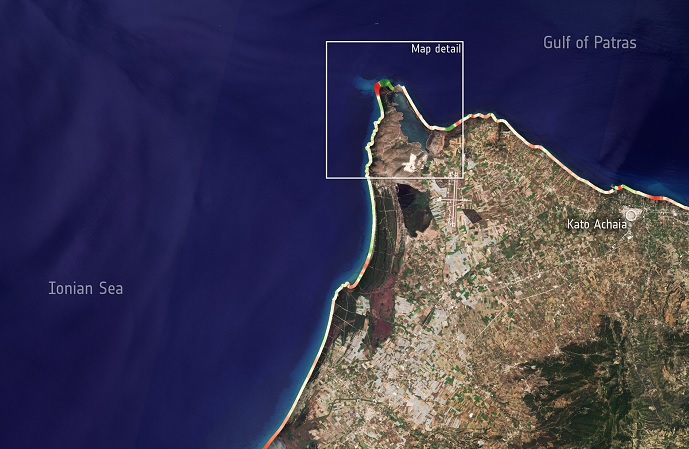
The European Space Agency (ESA) warned on Tuesday of the fragility of Greece’s shoreline and the likelihood of coastal erosion increasing in the coming years.
In a report on “Monitoring coastal changes in Greece,” ESA says that over the 1995—2020 period, around 40 percent of the Greek coastlines analyzed have shown “progradation,” which is the seaward growth of beaches caused by the progressive build-up of sediment.
The study found that nearly 10 percent of the studied coastal areas are subject to erosion of greater than 3 meters per year.
Deltas, estuaries and capes appear to be the most exposed areas with retreat that can reach 30 meters per year, the study says.
Erosion at river mouths are especially of great concern as this signifies a sediment deficit and suggests critical and long-lasting consequences for coasts deprived of sediment input from rivers, it adds.
The analysis shows that changes in the nearshore bottom slope, sandbar migration or even an overall increase in depth, are all worrying signs of sediment shortage that can forewarn or aggravate coastal erosion.
The team from the Space for Shore project, funded by the ESA, has processed hundreds of satellite images, including data from the Copernicus Sentinel-2 mission, from 1995—2020 to analyze over 900 km of coast in Greece – in the Peloponnese, Eastern Macedonia and Thrace regions.
Case of coastal erosion on Greece’s Zakynthos Island
As an example, the team studied Zakynthos Island, particularly the Laganas coastal area.
Given that the beaches are frequently watched by ecologists who closely monitor the migration of loggerhead sea turtles, they found it to crucial to observe the bathymetry and the waterline of the coast to record changes in its environmental impact.
Aurélie Dehouck, Head of i-Sea and coordinator of Space for Shore, commented, “Over the last 25 years, our analysis has revealed a strong variability in Greece’s coastlines, with extremely dynamic local changes.
“From this assessment of intra-period variability, two foregone conclusions emerge: the need to monitor coastal dynamics on crossed timescales to better identify sediment movement, problematic depletions and coastal responses to high-energy events, and the need to constantly monitor in order to know the real status of beaches of which the issues of the present and the future are based.”
Athanasios Nalmpantis from the Public Sector at the Region of Eastern Macedonia & Thrace, said that “through the Space for Shore project, a comprehensive set of in situ scientific measurements, combined with numerous retrospective remote sensing data were produced.
“Thus, an evidence-based up-to-date assessment framework for the extent of coastal erosion was provided, rendering it an extremely helpful and substantially incomparable toolkit to the coastal managers throughout the region, both for the present and future use,” he added.
The results of the Coastal Change from Space project were presented in an online webinar.
See all the latest news from Greece and the world at Greekreporter.com. Contact our newsroom to report an update or send your story, photos and videos. Follow GR on Google News and subscribe here to our daily email!



